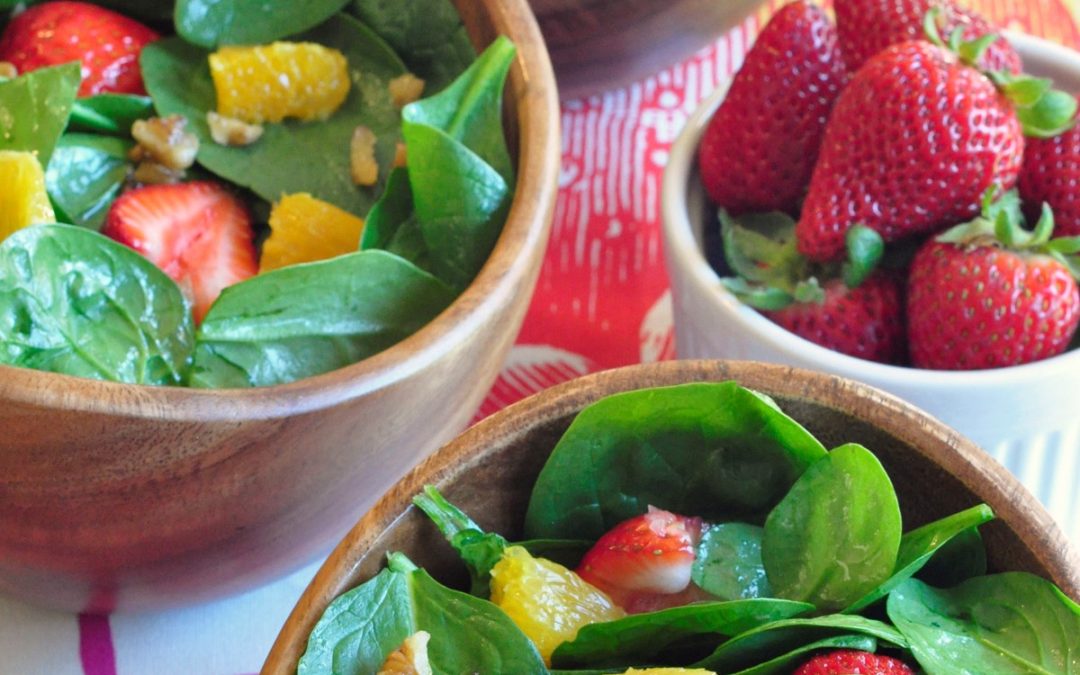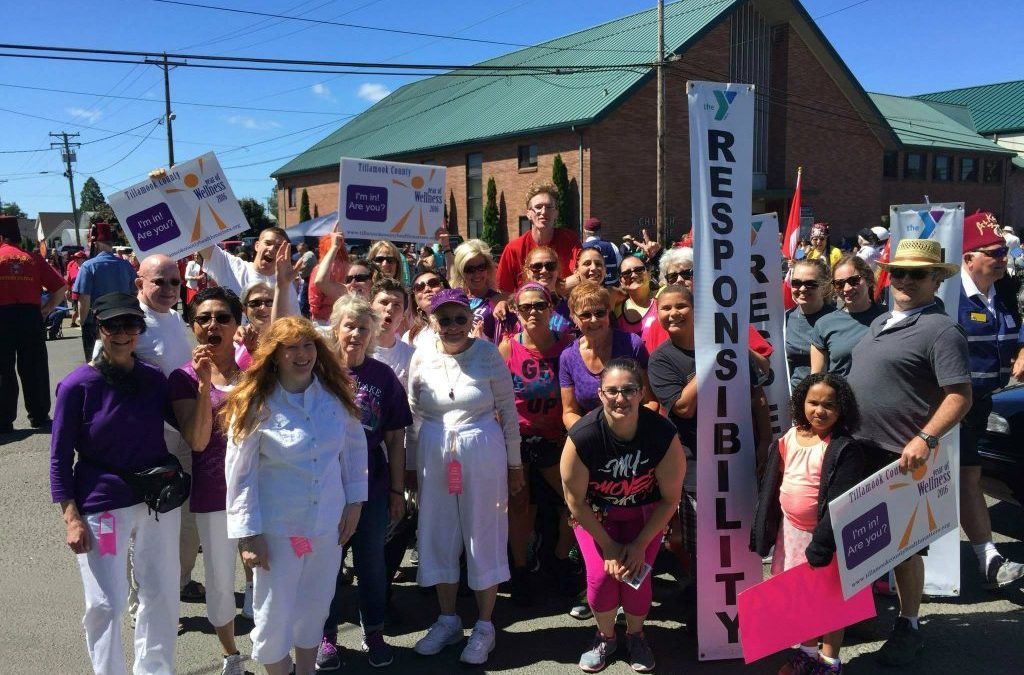
by Guest | Apr 27, 2018 | Recipes
Recipe Source: Recipe and photo from www.FoodHero.org
Number of servings:10
Time for preparation (including preparation and cooking): 15 min
Ingredients:
6 ounces spinach (about 7 cups)
3 oranges
1 1⁄2 cups strawberries, halved
1 cup walnut pieces (toasted if desired)
DRESSING
1 teaspoon sugar
1⁄4 teaspoon paprika
2 Tablespoons orange juice (juice from 1/4 orange)
1 Tablespoon lemon juice
1 1⁄2 teaspoons vinegar
1 teaspoon finely chopped onion
2 Tablespoons salad oil
Directions
- Wash and dry spinach, tear into pieces, and chill.
- To prepare orange: Cut off peel and membrane of outer part of the sections. Using a paring knife gently cut out sections from membrane edges. You end up with orange sections with no outer membrane.
- To make dressing: Combine all ingredients in a jar and shake well or blend in a blender.
- Right before serving, toss orange and strawberries with walnuts and spinach. Add dressing to coat salad. Serve immediately.
- Refrigerate leftovers within 2 hours.

by Guest | Apr 27, 2018 | Being Well
Emily Fanjoy, TCWRC Health Programs Coordinator
Health care professionals and social service providers understand that a person’s overall health is impacted more by what happens outside of the doctor’s office than by what happens during an annual visit. As YOW, a public health-focused initiative, convenes community partnerships and collaborators to formulate a plan to address the high rates of diabetes in Tillamook County, we are looking at root causes for type II diabetes and barriers to medical care for people who are pre-diabetic. That means looking across a broad spectrum of potential causes. A person’s relationships, past and present, and the home they grew up in could be a contributing factor to developing diabetes and to successfully managing it.
Healthy relationships promote overall health and well-being, while unhealthy and abusive relationships contribute to poor health in a variety of ways. Unhealthy relationships can negatively impact a person’s immediate and long-term health. Unhealthy relationships where one person in the relationship uses a variety of methods to gain and maintain power and control over the other person are, unfortunately, common. According to surveys from the National Domestic Violence Hotline, approximately 1 in 4 women and 1 in 7 men have experienced intimate partner violence. It occurs across every demographic line of socioeconomic status, education level, sexual orientation, race, and religion. It can happen to anyone. Tactics include: jealousy, preventing their partner from spending time with friends and family; controlling how their partner spends money; and shaming or humiliating their partner in public or in private.
Many people assume that abusive relationships are defined by the presence of physical violence, but research shows that emotional and psychological abuse are used long before any physical violence occurs. Over time the control tactics cause chronic, toxic stress for the person subjected to them. In terms of health impacts, psychological abuse is as important an indicator for health outcomes as physical abuse. This means a person can experience negative health consequences as a result of an unhealthy relationship without ever being physically hurt by their partner.
Controlling, abusive behavior harms the partner who is subjected to it, and it can also harm the health and wellbeing of children growing up in homes where it’s the norm. The Adverse Childhood Experience Study, or ACEs, demonstrated the connection between growing up with violence in the home and experiencing long term chronic health conditions, including diabetes. Our bodies are wired to respond to real or perceived threats by releasing the hormone cortisol to fuel the “fight, flight, or freeze” response in dangerous situations. This is helpful for self protection in the short term but, if the body is constantly producing stress hormones, the effect can be damaging over time. Cortisol directly impacts blood sugar levels and heart rate, and is linked to the development of gastrointestinal conditions, heart disease, diabetes, and other illnesses.
As with childhood ACEs, even after an unhealthy relationship has ended, the experience of abuse can negatively impact health. Successfully managing mental or physical health conditions while in an unhealthy relationship can be challenging. If you or someone you know are concerned that your relationship is affecting your health, there is hope for healing. At TCWRC, we believe everyone deserves a healthy, supportive relationship.
TCWRC serves people of all genders with free, confidential advocacy services, community resource referrals, support groups, community and professional education and outreach, and counseling services. Our advocates and 24/7 helpline are available to anyone who wonders about their relationship and about what resources are available to them. We’re located at 1902 2nd St, Tillamook, OR 97141; 503-842-9486 or 1-800-992-1679. You are not alone.

by Guest | Apr 20, 2018 | Being Well
Jessica Linnell, PhD, Oregon State University Extension Service, Family & Community Health
When I first moved to Tillamook two years ago to join the Oregon State University Extension Service as a professor in Family & Community Health, I started hearing something repeatedly from everyone I met, “We have culture of working together,” and there were many examples.
One of these stories came from my neighbor who told me about the flood in 1996. While he shared with me the details of how devastating the flood was, his focus was not on what happened but rather on how people came together to help one other.
Since the very beginning of my time living in Tillamook County, I have understood that no matter how big or complex a problem is, the people of Tillamook County will work together. In addition to the crises like floods that bring us together, we have some big, complex health issues in Tillamook County that also require the spirit of collaboration.
If you look at the latest health assessments of our county, chronic diseases dominate the top of the list. One of these is the alarming rise in type 2 diabetes. Recent estimates show that nearly 11 percent of Tillamook County residents are diagnosed with diabetes, which is more than the state average. Additionally, up to 25% are estimated to have prediabetes. This is why type 2 diabetes was selected as the priority health issue for the next phase of the Year of Wellness.
Addressing type 2 diabetes is going to require we all work together to create communities that empower healthy lifestyles. That is why we have integrated a model called Collective Impact to support this work. The Collective Impact model encourages organizations to move from isolated work to working together collaboratively, by creating a common agenda and sharing resources, materials, time, risks, benefits and rewards.
When businesses, organizations, and community members come together around one problem, they maximize their expertise and resources to create solutions that are effective, tailored to the community, and can be sustained over time.
To help illustrate how collective impact can be a useful approach in efforts like the Year of Wellness, I would like to share this quote from Community Tool Box, a resource from the University of Kansas.
“Not all problems are created equal – some are simple, some are more complicated, and some are truly complex. Each type requires a somewhat different approach to solving them.
- An example of a simple problem is learning how to bake a cake – the right “recipe” is essential, but once you’ve discovered it, replication will get you almost the same result every time.
- An example of a complicated problem is sending a rocket to the moon – the right “protocols and formulas” are needed, as are high levels of expertise and training. Experience is built over time to get to the right result, which can then be repeated over time with the expectation of success.
- An example of a complex problem is raising a child – there are no “right” recipes or protocols that work in every situation. There are many outside factors that influence the situation, and every situation is unique. Experience helps, but in no way guarantees success.
A single service program may be quite appropriate to addressing problems that are simple or only somewhat complicated. Collective impact, however, is an approach to solving complex social problems.”
The myriad factors that influence our risk for type 2 diabetes are the reason type 2 diabetes is a big and complex health issue. Our risk is not just related to what we eat and how much we exercise. It is also influenced by factors like our family history, access to health services, and family and social norms. Additionally, our physical environment as well as organizational and government policies can have a big impact on our ability to engage in healthy lifestyles. By harnessing our collaborative spirit, we will be able to maximize our potential to have collective impact on type 2 diabetes.

by Guest | Apr 20, 2018 | Recipes
Recipe Source: Recipe and photo from www.FoodHero.org
Number of servings: 6
Time for preparation (including preparation and cooking): 1 hour 5 min
Ingredients:
12 jumbo pasta shells (1/2 of 12 ounce package)
1 1⁄4 cups nonfat ricotta cheese
3⁄4 cup pumpkin puree
1⁄2 cup Parmesan cheese, grated
1⁄2 teaspoon garlic powder or 2 cloves garlic
2 Tablespoons dried basil
1⁄4 teaspoon ground sage
1⁄2 teaspoon salt
1⁄2 teaspoon pepper
1 cup pasta sauce
Directions:
- Cook pasta shells according to package directions. Drain, separate onto baking sheet and let cool.
- In a medium bowl, stir together ricotta, pumpkin, Parmesan, and spices. Reserve 1 Tablespoon Parmesan for topping.
- Preheat oven to 350 degrees. Choose a baking dish that holds all the shells in a single layer.
- Spread pasta sauce in the bottom of the baking dish. Fill each shell with about 3 Tablespoons of pumpkin mixture, and place shells close together on sauce in baking dish.
- Cover pan with foil and bake for 30 minutes. Remove foil, sprinkle with remaining cheese and bake for 15 minutes more.
- Refrigerate leftovers within 2 hours.
Notes:
Freeze unused pumpkin puree and add to soup, chili or pancake recipes.

by Guest | Apr 13, 2018 | Being Well
By Marlene Putman, Director, Tillamook County Community Health Centers and YOW Task Force Leadership Team Member
The Tillamook County Year of Wellness (YOW) has been a lot of things since it was formed in 2015. Whether you participated in the on-line wellness tracker, joined a partner organization for an event, tried new recipes, or just became more aware of your personal lifestyle habits, you have been a vital part of this grass-roots effort to make Tillamook County a healthier and happier place to live, work and play.
Appointed by the Board of County Commissioners, YOW’s 22-member Task Force continues to meet regularly. To build on the work to date and to have an even greater impact on our population’s health, this body decided to focus on one community health priority: Preventing Type 2 Diabetes.
Risk factors for Type 2 Diabetes are the same as for many other chronic diseases, such as heart and lung disease, stroke and many forms of cancer. Tobacco use, poor nutrition and inactivity are key lifestyle behaviors that increase risk for chronic illness. Environmental factors like stress, lack of social support and reduced access to health-promoting activities, nutrition and healthcare also contribute to one’s risk.
Because environment and lifestyle play such a significant role in chronic disease risk, the new YOW framework will be focused on shaping policies and access to make the healthful choices the easier choices. Examples of this could include building walking trails, changing cafeteria menus, and holding walking meetings in the workplace. Joining newly formed walking groups, or starting your own, is a great way to become more active and increase social ties. YOW partners offer many wellness events, activities and classes. Taking a cooking class or joining a diabetes prevention class is another great way you can get started making healthier changes right now.
A key goal is to assess, and restructure when feasible, the environments where people live, work and play to optimize healthful choices. To reach our goal of reducing the number of people at risk for Type 2 Diabetes, it is important that these habits are established early in life. For example, families can plan more meals and snacks at home with more fruits and vegetables. They can take advantage of youth programming after school and over the summer months to ensure their kids stay active and develop positive social and emotional skills.
YOW is about working together at every level of a community – between friends, family, and co-workers, between organizations, and with leadership at the local and state levels – to maximize community health while at the same time, reducing the cost burden of chronic disease.
It is important to note that YOW partners provide many services for people who have Type 2 Diabetes, Prediabetes and other chronic health conditions, such as heart disease. This good work will continue and will likely only be enhanced through the continued partnerships and networking that emerge from the new YOW framework. We continue to convene partners around key health promotion topics where resources can be shared and used for maximum community benefit.
Tillamook County is a special place where elected officials, healthcare leaders, businesses and non-profit directors work together. YOW is even more special in that passionate community volunteers can serve on committees and help shape which actions will best help us reach our goal of preventing Type 2 Diabetes. If you are interested in learning more, contact our coordinator, Michelle Jenck, at (503)812-8354.
We strive to ensure that Tillamook County residents have evidence-based, relevant health and wellness information at their fingertips. Visit tillamookcountyhealthmatters.org or download the Tillamook County YOW App for the latest blogs and recipes. View our calendar and classes pages to learn how you can get connected to wellness events in our community. And follow us on Facebook for news and updates on partner events, classes and walking group details.





